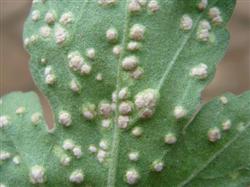Control of diseases and insect pests of chrysanthemum

The serious disease of chrysanthemum is chrysanthemum leaf spot, which occurs from the lower leaves of the plant, and the disease spots are scattered on the leaves. At first, the green spot faded, and then it became brown or black, and the spot gradually expanded into a round, oval or irregular shape. Diameter 2 mm to 10 mm, gradually expand and increase, spread upward from under the plant, severe disease spots United into pieces, leaves withered and drooping, hanging upside down on the stem, affecting the whole plant. The pathogen overwintered by conidia on diseased plants or diseased bodies in soil, spread by wind and rain and invaded by stomata. The disease occurs from April to October every year, especially in the hot and humid season from May to August. Therefore, we should strengthen the management at ordinary times, and avoid splashing and watering to wet the lower leaves. Planting is not too dense, strengthen ventilation and light. Once diseased leaves are found, remove and destroy them in time, and spray 65% Dyson zinc wettable powder 500 times, or 75% chlorothalonil wettable powder 500 times, or 10% Bordeaux solution every 7 to 10 days. The disease can be controlled for 3 to 4 times in a row, or spraying 1000 times of 50% topiramate or 50% carbendazim before the onset of the disease has a good control effect. The common pests of chrysanthemum are aphids and red spiders. Aphids occur from the beginning of seedlings to the end of flowering. Aphids appear when they germinate in spring and live on tender stems and leaves and suck sap. It can reproduce for dozens of generations in autumn, harming bud cores and petals. The damaged plants were yellowed and deformed, the buds were spoiled, and the florescence was shortened. When aphids are found, 40% omethoate 1500 times to 3000 times solution, 25% ammonium parathion 1000 times solution, 50% aphid pine agent 1500 times solution can be used. Red spiders mostly occur in the summer high temperature and dry season, latent dry, leaf back, prick suck leaf juice, so that the leaves dry yellow and withered flowers. Flowering also harms the petals and makes the flowers wither quickly. After the red spider was found to be harmful, 40% omethoate 1000 times, or 80% dichlorvos 1000 times, or 40% dicofol 1000 times to 1500 times solution, all had significant effects. In the period of high temperature and dry in summer, the spray of clear water also has a certain preventive effect.
Related
- Fuxing push coffee new agricultural production and marketing class: lack of small-scale processing plants
- Jujube rice field leisure farm deep ploughing Yilan for five years to create a space for organic food and play
- Nongyu Farm-A trial of organic papaya for brave women with advanced technology
- Four points for attention in the prevention and control of diseases and insect pests of edible fungi
- How to add nutrient solution to Edible Fungi
- Is there any good way to control edible fungus mites?
- Open Inoculation Technology of Edible Fungi
- Is there any clever way to use fertilizer for edible fungus in winter?
- What agents are used to kill the pathogens of edible fungi in the mushroom shed?
- Rapid drying of Edible Fungi



